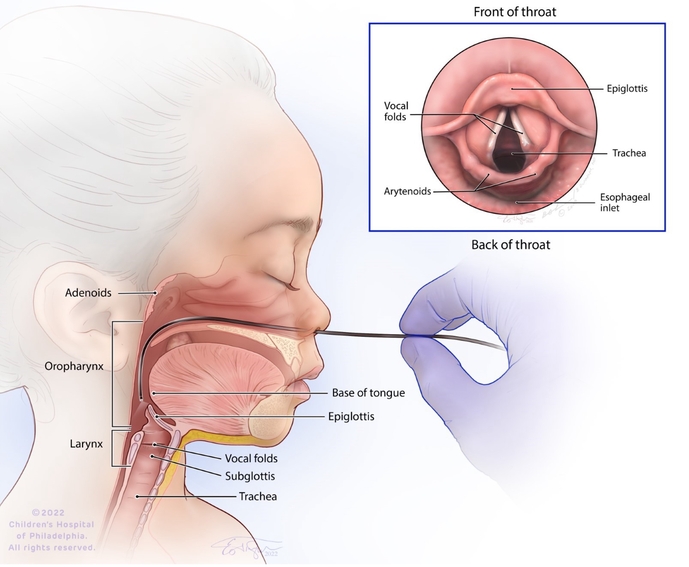Flexible Laryngoscopy
What is a flexible laryngoscopy?
When you bring your child to Children’s Hospital of Philadelphia (CHOP) for an evaluation of their ears, nose and throat, we may use a diagnostic procedure called a “scope” or flexible laryngoscopy. The flexible laryngoscopy (also called nasopharyngolaryngoscopy or NPL) is a diagnostic procedure used during your child’s ENT evaluation to examine the internal structures of the nose, throat, upper airway and vocal cords.
During the procedure, a spaghetti-like fiberoptic camera is inserted in your child's nose and moved inward to look into the back of their throat.
In most cases we will perform a flexible laryngoscopy in our office to help confirm your child’s diagnosis and rule out other conditions.

Common reasons for a flexible laryngoscopy
We may use a flexible laryngoscopy to examine your child if your child is experiencing any of the following symptoms:
- Noisy breathing or stridor
- Shortness of breath or difficulty breathing
- Hoarse voice
- Snoring
- Nosebleeds
- Nasal obstruction
- Feeding difficulties
What to expect during a flexible laryngoscopy
A flexible laryngoscopy is performed in our office with you or another caregiver present. It is a very brief procedure that typically takes anywhere from 30 seconds to a couple of minutes.
While your child sits up in a chair (an infant or young child will sit on a parent or caregiver’s lap), your ENT provider will place the scope in through your child’s nose. They will slowly move the scope while looking through the eyepiece of the scope. Your child may be asked to vocalize different sounds so we can evaluate the movement of the vocal cords. The images may be visible on a monitor for you and your child to watch.
Pain and medication
A flexible laryngoscopy does not require sedation, and while your child may experience some discomfort, the procedure is not painful. Your ENT provider will talk to you about options for medication prior to performing the procedure. Sometimes, a small amount of numbing medicine can be put in your child’s nose to make the procedure more comfortable. At other times, medicine is not needed, or it will interfere with the results.
Side effects
Most commonly, there are no problems after a flexible scope, and there is typically no pain in the nose after the scope is removed. Common side effects during the scope are coughing, gagging, sneezing or watery eyes. On rare occasions, there can be a small amount of bleeding from the nose after the scope is completed.
If your child had numbing medicine used, they should not eat or drink anything for about 30 minutes until the medicine wears off.
How to help your child prepare for a flexible laryngoscopy
It is common for children to be scared or uncomfortable about procedures. Children tend to respond best to situations they are prepared for. There are a few ways you can help prepare your child for a flexible laryngoscopy:
- Talk with your child about going into the room.
- Give a simple explanation of the procedure.
- Practice a coping plan together.
- Practice taking deep breaths together.
Here at CHOP, our team of ENT providers is here to help make the procedure as comfortable as possible for your child.